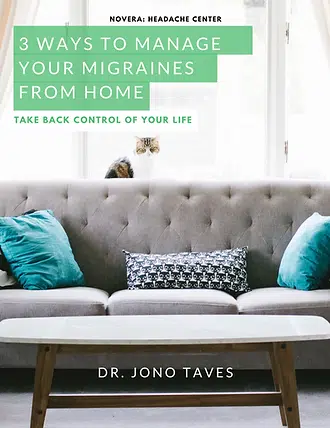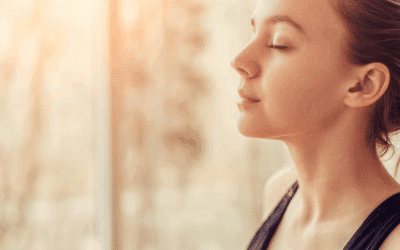Stress is a known and common trigger for headaches and migraines. When we learn ways to manage our stress, it can have a positive impact on our ability to reduce the frequency and severity of our migraines. One technique you can use for stress management is the practice of mindfulness. Mindfulness is when we take a moment to pause and observe what is going on in our bodies and around us without judgment. We can observe our emotions, our sensations, our movements, our breath, our thoughts, and more as a way to connect with ourselves and help regulate our nervous system. Mindfulness techniques have been shown to reduce stress, help manage anxiety and depression, improve sleep and reduce pain. Mindfulness has even been shown to reduce headaches by way of reducing muscle tension, increasing feelings of relaxation, and reducing the trigger of stress. There are several mindfulness techniques that can be used for stress management:
Deep Breathing: Taking slow, deep breaths can help activate the body’s relaxation response, which can help reduce stress and tension in the muscles. You can add a layer of mindfulness to deep breathing by focusing on your breath as you inhale and exhale. You can observe without judging your body what part of your body is moving when you breathe and what parts of your body remain still. Here is an example of a mindful breathing practice:
- Find a comfortable place to lie down or sit. Set a timer for yourself for 2-5 minutes.
- Close your eyes and take a few deep breaths in through your nose and out through your mouth.
- Begin to focus on your breath, paying attention to the sensation of the breath entering and leaving your body.
- Notice the sensation of the breath as it moves in and out of your nose or mouth. Notice the rise and fall of your chest or the expansion and contraction of your belly. Notice how your ribs move as you inhale and exhale. Do your ribs expand and then come closer together? Resist the temptation to judge your body’s movements. Just notice.
- If your mind wanders, gently bring your focus back to your breath.
- Continue to focus on your breath for several minutes, or for as long as you feel comfortable.
- When you are finished, take a deep breath in and exhale fully. Slowly open your eyes.
*If you are in a moment that is particularly stressful and you cannot get to a quiet place for the above practice, you can try box breathing. For this mindful breathing technique inhale for 4 counts, hold for 4 counts, exhale for 4 counts, hold for 4 counts and repeat.
Body Scan: A body scan is a technique that involves paying attention to each part of the body and releasing any tension. Here is an example of a short mindful body scan. You can spend anywhere between 5-30 minutes with this practice, depending on how long you spend observing each body part:
- Begin by closing your eyes and taking a few deep breaths.
- Bring your attention to your toes, and notice the sensation of your toes resting on the surface beneath you.
- Slowly move your attention up your body, from your toes to your feet, your ankles, your calves, your knees, and so on, noticing the sensation of each body part resting on the surface beneath you.
- Continue moving your attention up your body, noticing the sensation of each body part as you go: your thighs, your hips, your lower back, your stomach, your chest, your shoulders, your arms, your hands, your fingers, your neck, your jaw, your cheeks, your forehead, and the crown of your head.
- Once you have scanned your whole body, rest in the awareness of your entire body lying on the surface, simply be with the sensation of your breath, and let go of any thoughts or judgments that arise.
- When you are ready, slowly open your eyes.
Yoga: Yoga combines physical movement with deep breathing and meditation, which can help reduce stress and promote relaxation. Here are examples of a few yoga postures to help with relaxation. These can be held for 5 breathes or longer if it feels good in your body::
- Child’s pose – can be used for relaxation if the shoulders and upper back
- Corpse pose – can be used for overall body relaxation and tension release.
- Legs up the wall – can be used to reduce tension in the legs and lower back.
- Cat-cow – can be used for spinal mobility and to reduce spinal tension.
- Supine twist (open book) – can be used to release tension in shoulders, neck, and chest.
- Reclined bound angle – can be used to open up and relax hips. You can place a rolled-up towel, blanket, or yoga blocks under your knees to fully relax into this position.
Progressive muscle relaxation (PMR): PMR involves tensing and then relaxing different muscle groups, which can help release tension and promote relaxation. Here is an example of a short PMR. If you have an injury or pain spots in your body you can skip over that part of your body if needed. As always, it’s also a good idea to consult your medical provider if you have a medical condition before using this PMR technique:
- Find a comfortable spot to lie down or sit.
- Begin by taking a few deep breaths and focusing on your breath.
- Starting with your feet, tense the muscles in your feet as tightly as you can for a count of five.
- Then, release the tension and allow your feet to relax completely for a count of 10.
- Move on to your calves and repeat the process, tensing the muscles for a count of five and then relaxing them for a count of 10.
- Continue to work your way up your body, tensing and relaxing each muscle group in turn: your thighs, your stomach, your chest, your arms, your hands, your neck, and your face.
- Once you have tensed and relaxed all of the muscle groups in your body, focus on your breath and notice any sensations of relaxation in your body.
- Repeat the process if desired, and when you’re ready, slowly open your eyes and come back to your day.
Guided imagery: Guided imagery is a technique that involves using your imagination to visualize a peaceful and calming scene, such as a mountain hike, to promote relaxation. Here is an example of a guided imagery practice for a mountain hike:
- Find a comfortable and quiet place to sit or lie down.
- Begin by closing your eyes and taking a few deep breaths.
- Imagine yourself at the base of a mountain, surrounded by tall trees and lush greenery.
- Take a step forward and start to climb the mountain trail. As you hike, notice the sights and sounds around you. You might see birds singing, wildflowers blooming, and a clear blue sky overhead.
- Feel the warmth of the sun on your skin, and the coolness of the breeze on your face.
- Hear the sound of your own footsteps as you climb higher and higher.
- As you reach the top of the mountain, imagine yourself standing on a beautiful peak, overlooking a breathtaking view.
- Take in the sights and sounds around you. You might see a lake, a river, or other landscapes in the distance.
- Take a deep breath and feel the sense of accomplishment and peace that comes with reaching the summit.
- Spend some time at the top, enjoying the view and the tranquility.
- When you’re ready, imagine yourself hiking back down the mountain, feeling refreshed and renewed.
- When you reach the bottom, take a deep breath and slowly open your eyes.
When doing a guided imagery practice what is important is to try to imagine your scene in as much detail as possible. Try to engage your five senses as you do this. What do the flowers smell like, what sounds do you hear from the wind, birds, etc? You can use this practice with images that are associated with positive memories like baking bread, sitting on a beach, or sitting in front of a warm fire with a good book. It’s less about the specific setting and more about engaging your senses in something that helps you relax and feel peaceful.
It’s important to experiment with different techniques and find the ones that work best for you. Incorporating them regularly into your daily routine can help you manage stress in a more effective way which can have an overall positive impact on reducing triggering your headaches and migraines.




